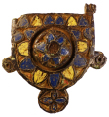Julian Kerry

Julian Kerry is living in the house which his great great grandfather Willie Garland bought. He remembers visiting this house since he was a child. The home is Croft Acre, Fersfield which like many homes round here was a small holding.

Julian thinks that Fersfield (unlike Bressingham) has not changed much in appearance as there have been no new buildings. Julian remembers Fersfield had 2 or 3 pubs and a post office – but they are now gone. Does anyone remember these and can tell us something about them? Julian’s grandfather came from South Lopham at Fen Farm and he married one of the Garland sister. They then moved to Willow Farm in Fersfield. Julian’s father lived in a house near Pillar Box Corner, Bressingham. So Julian has lived in either Fersfield or Bressingham most of his life.

His father like Julian was a builder. He worked with Maurice Peachey and they called themselves Kerry and Peachey until 1971 when Julian joined his father and they worked as Kerry and Son. They built another house at Pillar Box Corner and then they bought Drift House in Bressingham which was derelict and which they restored. Later when his father sold the house for £2,000 he spent £1,000 on buy a new Jaquar car! Julian said that as a child he spent a lot of time living in a caravan while his father either built or restored their home.
In 1971 Julian worked with his father as a builder and they became Kerry and Son. During the years Julian and his father did a lot of work in the community including the churches. Julian went to Bressingham School and then on to Diss Grammar. Later when he married he had 3 daughters – 2 live in Norfolk and 1 in Essex. Sadly Julian’s wife died 8 years ago. Julian has a medal which he inherited from his Great Aunt Hilda Garland (who later became Welch).
It is dated 1910 and it is for ‘Regular School Attendance’.

Julian also has the photo of the Stool Ball Club dated 1915. His mother Myra Kelly found this photograph and thought that the girl on the bottom row, third in on the right, is one of the Garland sisters. Julian wonders if there is anyone in the community that can help him identify any of the other girls? If so please be in touch with him via the website email.
I asked Julian in what way things had changed since he as young and especially since he was working with his father as a builder. He said everything was ‘hand tools’ then – nothing electrical. His father in the early days, would ride to jobs on his cycle rather than in a van, so life was very hard. His father died comparatively young.













